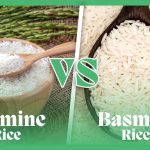Cooked rice is a staple cuisine in many cultures worldwide and a nutritional powerhouse in addition to being tasty and adaptable. Millions of people have a particular place in their stomachs and hearts for rice. Cooked rice has numerous nutritional advantages that are sometimes disregarded, in addition to its reputation as a comfort food staple.
Rice is a symbol of nourishment and togetherness across cultures due to its variety in cuisines and its importance as a source of sustenance for billions of people. Maintaining a healthy, balanced diet requires understanding cooked rice’s nutritional content.
Rice:
Asian rice (Oryza sativa) and African rice (Oryza glaberrima) are grass species from which rice is derived. It is a staple diet, for about half of the world’s population, particularly in Asia. After maize and sugarcane, this starchy grain is the agricultural product with the third-highest production in the globe.

Types/variety of rice:
Numerous cultivars of rice can result from variations in genetics, grain length, color, thickness, stickiness, aroma, growing technique, and other attributes. Following are the two main types of rice available:
Brown rice: Brown rice is made from whole grains; only the seed’s inedible shell is removed.
White rice: During milling, bran, and germ are also eliminated from white rice.
Nutritional composition:
The nutritional composition of rice varies among types.
White rice is refined, polished, and free of bran and germ. This improves cooking quality, shelf life, and flavor, but drastically diminishes nutritional value. However, producers typically enhance white rice or substitute some vitamins after processing. At the same time, brown rice is naturally full of important nutrients.
| Nutrients (per 100 grams) | White rice | Brown rice |
|---|---|---|
| Calories | 129 kcal | 122 kcal |
| Protein | 2.67 g | 2.73 g |
| Carbohydrates | 27.99 g | 25.45 g |
| Fiber | 0.4 g | 1.6 g |
| Fats | 0.28 g | 0.96 g |
| Calcium | 10 mg | 3 mg |
| Iron | 1.19 mg | 0.56 mg |
| Magnesium | 12 mg | 39 mg |
| Phosphorus | 43 mg | 102 mg |
| Potassium | 35 mg | 86 mg |
| Sodium | 245 mg | 202 mg |
| Zinc | 0.49 mg | 0.71 mg |
| Vitamin B1 | 0.162 mg | 0.177 mg |
| Vitamin B2 | 0.013 mg | 0.069 mg |
| Vitamin B3 | 1.467 mg | 2.548 mg |
| Vitamin B6 | 0.092 mg | 0.122 mg |
| Vitamin B9 (Folate) | 58 µg | 9 µg |
| Folic acid | 55 µg | 0 µg |
| Choline | 2.1 mg | 9.2 mg |
| Vitamin E | 0.04mg | 0.17 mg |
Calories:
According to USDA, 100 grams of white rice renders a total of 129 kilo-calories of energy while brown rice provides 122 kilo-calories of energy.
Proteins:
White rice (2.67 g) and brown rice (2.73 g) provide almost similar amounts of proteins.
Carbohydrates:
Even though the carbohydrate content of white rice (27.99 g) is higher than brown rice (25.45 g), brown rice contains more dietary fiber. Dietary fiber is essential for maintaining a healthy digestive system.
Fats:
White rice provides 0.28 grams of fats while brown rice renders 0.96 grams of fats.
Micronutrients:
The micronutrients found in white rice include calcium, iron, magnesium, phosphorus, potassium, sodium, vitamin B-complex, choline, and vitamin E.
Similarly, brown rice incorporates calcium, iron, magnesium, phosphorus, potassium, sodium, vitamin B-complex, choline, and vitamin E.
Cooked rice carbohydrates:
Carbohydrate is the primary composition of rice. Almost 80% of the total dry weight of rice is made up of carbohydrates. The most common form of carbohydrate in rice is starch, which is made up of long chains of glucose called amylose and amylopectin. The amount of these compounds is different in different types of rice, because of which the texture of rice is affected.
The high content of amylose in rice does not let the rice stick together after cooking, such as in Basmati rice. While rice rich in amylopectin makes the rice stick together after cooking, such as sticky rice or glutinous rice. These types of rice are ideal for making rice pudding, sushi, and rice cakes. The digestion of rice by the body is also affected by amylose and amylopectin. Rice rich in amylose is digested slowly in the body and vice versa.
A single serving (150 g) of white rice has more than 53 grams of carbohydrate. Only a small portion of that carbohydrate comes from fiber. Most of it is starch, with a tiny quantity of sugar. Short-grain rice often has a higher glycemic index than long-grain, medium-grain, and brown rice.
Role in human nutrition:
Rice nutritional content varies depending on the variety and cooking method used. Bran and germ have a high vitamin and mineral content. Aside from supplying energy and essential nutrients, refined white rice has no health benefits. Enriched white rice does contain additional B vitamins, which are beneficial to health. On the other hand, frequent eating of brown rice, also known as whole grain rice, can have health benefits.
Heart health:
Whole grains enhance blood cholesterol and lower the risk of heart disease, stroke, type 2 diabetes, and obesity. Brown rice includes a variety of heart-healthy nutrients, including minerals, antioxidants, lignans, and dietary fiber.
Prevention from chronic diseases:
White rice has fewer antioxidants and other plant components than brown rice. Pigmented rice, especially red-grained kinds like purple rice, is high in antioxidants.
Brown rice bran may include lignans and ferulic acid.
lignans: it has been linked to a lower risk of heart disease, menopausal symptoms, osteoporosis, and breast cancer.
ferulic acid: Rice bran contains ferulic acid, a powerful antioxidant. It contains anti-inflammatory and antibacterial properties and may help to prevent cancer and diabetes.
Supports Muscles and bones:
White rice has 12 mg of magnesium, which might help you meet the 420 mg daily recommendation. Magnesium is a structural component of bones that aids in hundreds of enzymatic activities involved in DNA and protein synthesis, as well as being essential for correct nerve transmission and muscular contraction.
Cancer prevention:
Rice is high in insoluble fibre, which protects against several forms of cancer. Many scientists and experts feel that the insoluble fibres found in rice are essential for protecting the body from the growth and spread of malignant cells. Fibre is especially effective in the fight against colorectal and intestinal cancer.
Aside from fibre, rice contains natural antioxidants such as vitamin C, vitamin A, phenolic, and flavonoid chemicals, which act as or encourage antioxidants in the body to scavenge free radicals. Free radicals are by-products of cellular metabolism that can harm organ systems and cause healthy cells to become malignant. In such instances, rice can assist raise the body’s antioxidant levels.
Beneficial for irritable bowel syndrome:
Rice is high in resistant starch, which enters the colon undigested. This form of starch promotes the growth of beneficial bacteria, which aid in proper bowel motions. Furthermore, this insoluble rice is extremely beneficial in the treatment of illnesses such as Irritable Bowel Syndrome (IBS) and diarrhea. You may take white or brown rice for irritable bowel syndrome.
Regulation of body temperature:
The water used to boil rice is referred to as rice water. The presence of rice water is associated with high-temperature rice, which delivers starch in water. Rice water helps to regulate body temperature. Consumption of rice water therefore heals fevers while also regulating body temperature. As a result, rice is used as a fever-reducing agent.
Metabolism and Heart Function:
Thiamine is essential for turning carbs, lipids, and proteins into energy. It aids your body in releasing the potential fuel held inside your diet. It is also necessary for maintaining a normal cardiac rhythm and appropriate heart muscle contraction. It helps ensure that your heart pumps efficiently.
Nervous and muscle function:
Thiamine is required for adequate nerve impulse transmission to your muscles, allowing them to perform normally and create strength. It is also required for the efficient operation of your neurological system, which ensures smooth communication between your brain, nerves, and muscles. A deficit can cause nerve injury and neurological disorders.
Synthesis of DNA:
Selenium is a component of enzymes that aid in the creation and repair of DNA, the blueprint for all cells in the body.
Protection from oxidative damage:
Selenium acts as an antioxidant, combating free radicals, which are toxic chemicals that destroy cells. This defense is essential for overall cellular health.
Hormonal function:
Selenium aids in the normal operation of thyroid hormones, which govern metabolism, growth, and development.
Regulation of blood pressure:
Magnesium relaxes blood arteries, which contributes to normal blood pressure levels.
Energy production and synthesis of protein:
Magnesium is required for tissue growth and repair throughout the body. It also helps to transform meals into useful energy, which keeps you going throughout the day.
Cell growth and DNA repair:
Folate promotes DNA repair and cell development. Plays a critical function in cell development and DNA repair, especially during pregnancy.
Improves Gut Health:
Rice includes more resistant starch after it is cooked and cooled. Resistant starch can produce certain fatty acids that assist the colon stay healthy. These fatty acids may reduce the risk of colorectal cancer.
Safe for Celiac patients:
Rice is a naturally gluten-free grain, making it beneficial to those with celiac disease and non-celiac sensitivity.
Skin health:
Black rice, brown rice, rice bran oil, and rice water are all utilized in skin care treatments. Rice powder can be administered topically to treat some skin conditions. In Asia, ayurvedic practitioners commonly recommend rice water as an excellent treatment for cooling irritated skin surfaces. The phenolic chemicals present in it, notably in rice, have anti-inflammatory characteristics, making them effective for relieving inflammation and redness.
Side effects:
Rice is a safe food staple. Regular rice consumption, however, may pose dangers, particularly if it accounts for a considerable portion of a person’s daily dietary intake.
Diabetes risk:
Type 2 diabetes is a common condition that causes high blood sugar levels. White rice may increase the risk of type 2 diabetes. Eating too much white rice may cause a surge in post-meal blood sugar and insulin levels. This is because it has a high glycaemic index, which means it can cause considerable blood sugar spikes after eating. The glycemic index of white rice is 73 which is more than brown rice glycemic index i-e 68.
High glycemic index diets may increase the risk of acquiring diabetes. Brown rice, like other whole grains high in fiber, may help lower the incidence of type 2 diabetes.
Consuming cooked white rice that has been chilled for 24 hours and then reheated may dramatically reduce your post-meal blood sugar levels compared to freshly prepared white rice. Allow white rice to cool to room temperature before eating, or store it in the refrigerator for later use if feasible. This seemingly simple procedure enables starch degradation to proceed.
As the cooked rice cools, the starch molecules rearrange and form resistant starch. Unlike conventional starch, resistant starch is not completely digested by the small intestine, resulting in a lower influence on blood sugar levels. This might lead to a smaller blood sugar increase after eating compared to freshly cooked white rice.
Anti-nutrients:
Brown rice includes an antioxidant called phytic acid (phytate). This is classified as an antinutrient because it stops the body from absorbing vital minerals like iron and zinc.
Allergies:
Rice allergy is rare, but it is conceivable. Rice allergy is more common in Asian countries where rice is a staple diet. People with rice allergies may also be sensitive to corn, soy, and barley, or vice versa.
Rice and cholesterol, friend or foe?
Although rice does not contain cholesterol, it can have an effect on the body that causes cholesterol or triglycerides to rise. The type of rice a person consumes may influence whether they risk raising their cholesterol, such as a high intake of refined or white rice. This also depends on whether the person consumes white or refined rice on a regular basis, as well as the portion size.
If a person has risk factors for high cholesterol, such as obesity, inactivity, or a poor diet, white rice may serve as an adversary and raise their cholesterol level. Eating high-fiber rice instead of white rice may help you lose weight and lower your cholesterol.
Rice and weight loss:
There’s a reason why white rice is often avoided in weight loss plans. Its high carbohydrate content and calorie count may appear to be a deterrent when attempting to lose weight. It is high in starch, which inhibits efficient weight loss.
Individuals can utilize parboiled rice, which is processed using a unique method that increases its nutritional value and changes the texture, making it an excellent alternative for individuals wanting to reduce weight.
It improves gut health because it is an excellent prebiotic source that promotes beneficial gut bacteria. It helps to improve insulin sensitivity because it has a low glycemic index and regulates blood sugar levels. It promotes bone and hair health due to its high iron and calcium content. It contains a high concentration of B vitamins, which aid in hormone regulation.
To minimize the calorie count of your rice, cook it with more water and drain it after boiling. This procedure helps to eliminate extra starch from the rice. This boiling process minimizes the starch content and creates fluffy, distinct grains, making it a suitable alternative for individuals who wish to enjoy rice without gaining weight.
For those aiming to lose weight, brown rice can replace white refined rice in their diet. Brown rice is high in fiber, which helps to lower cholesterol. It can fill your stomach and leave you satiated with fewer calories, allowing you to eat less overall, which may aid with weight management. Brown rice provides several vitamins and minerals that are vital for the immune system, thyroid function, and other bodily functions.
Storage and safety:
Cooked rice should be stored carefully to ensure food safety. Without proper storage, cooked rice can enter the temperature danger zone (40 to 140 degrees Fahrenheit), where hazardous germs reproduce the fastest. The bacteria Bacillus cereus, in particular, is frequently connected with rice because its spores can be detected on raw, uncooked grains and can survive the cooking process. Eating rice contaminated with Bacillus cereus can cause unpleasant bodily symptoms such as vomiting, diarrhea, or nausea. After cooking the rice, allow it to cool before storing it in the refrigerator and using it within three to four days.
To summarize, rice is a wonderful and versatile base for a wide variety of foods. Understanding the many types of rice, their nutritional profiles, and how cooking methods affect them, as well as correct storage, allows you to make informed decisions about including rice in a balanced diet.
For a genuinely balanced and fulfilling lunch, serve rice with veggies, lean protein, and healthy fats. So, the next time you grab a steaming bowl of rice, do it with confidence, knowing that you’re not only eating a tasty staple but also providing your body with a variety of necessary nutrients.









